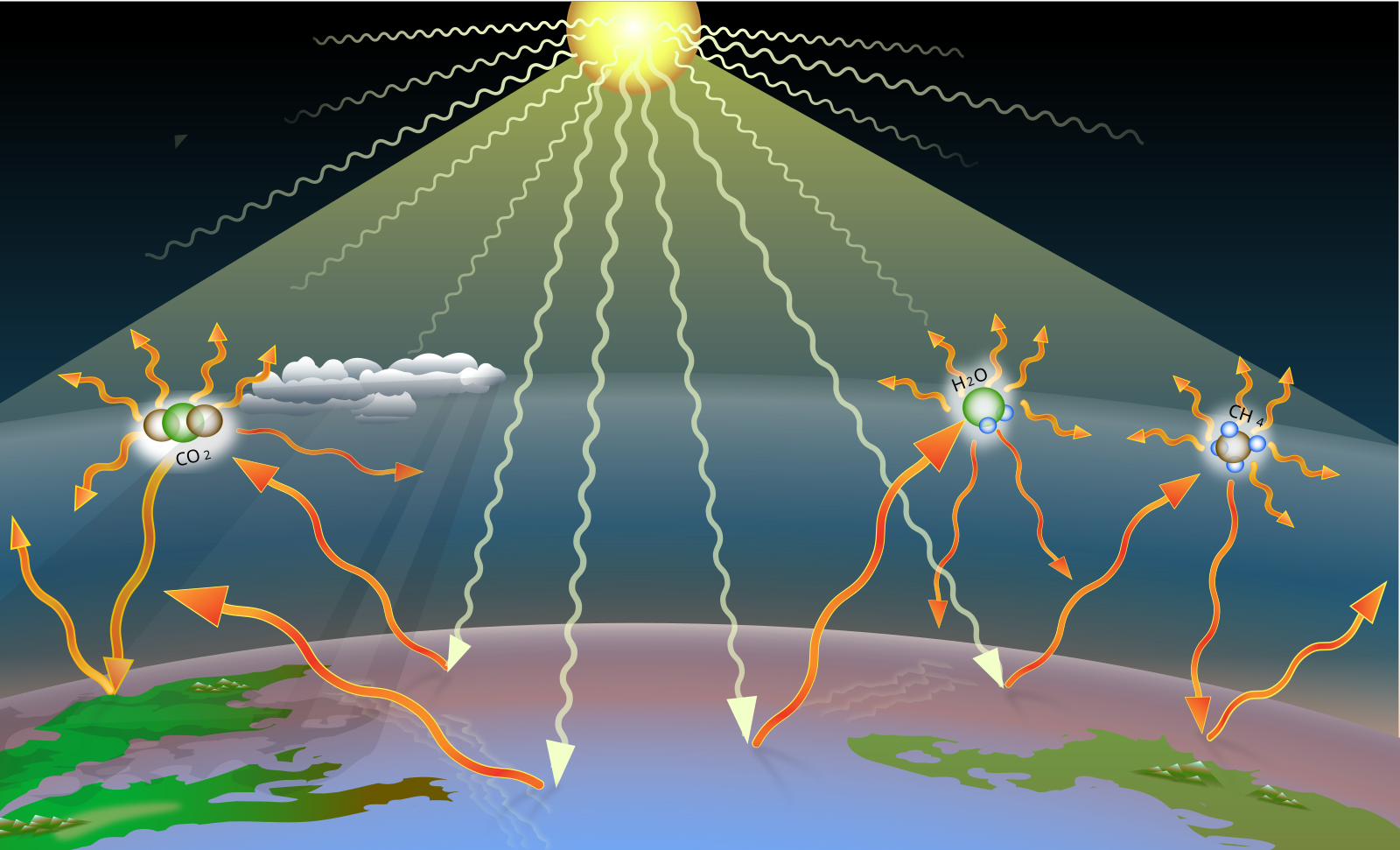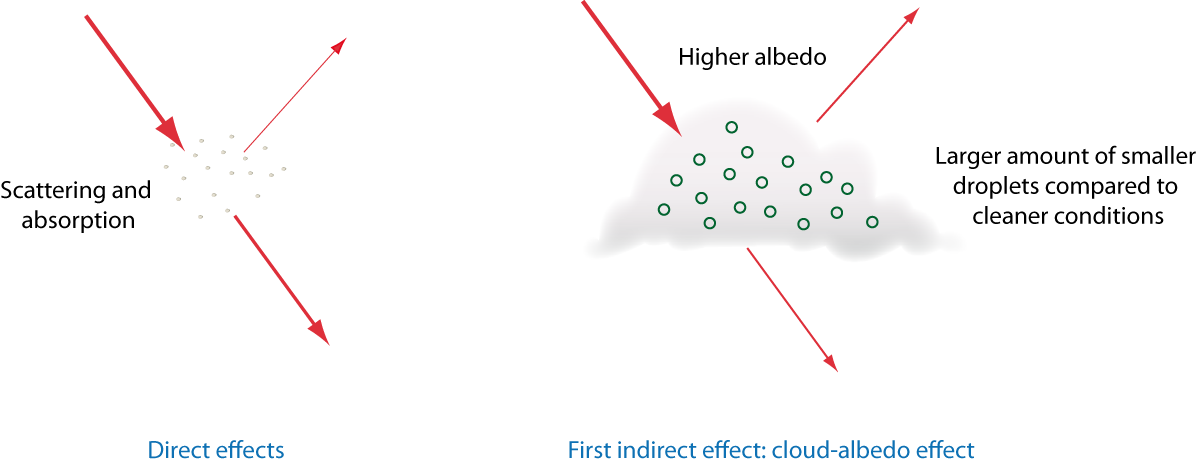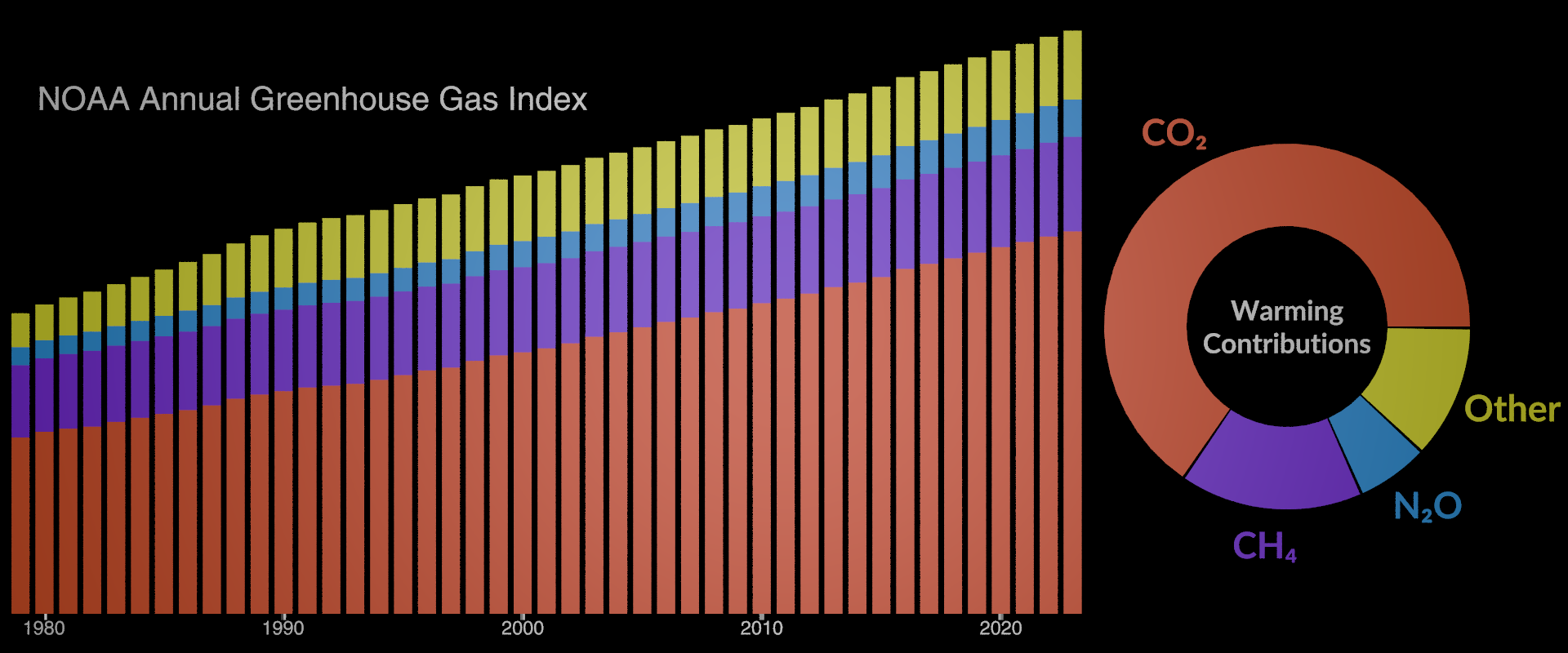IB Syllabus focus:
‘Water vapour, CO₂, CH₄, N₂O and black carbon absorb/re-emit longwave radiation, altering radiative forcing. Water vapour is dynamic and typically excluded from mitigation targets.’
The interaction between greenhouse gases (GHGs), aerosols, and radiative forcing plays a central role in shaping Earth’s climate system. Understanding these mechanisms is crucial for assessing anthropogenic impacts and future climate change trajectories.
Greenhouse Gases and Their Role
Key Greenhouse Gases
The atmosphere contains several GHGs that trap heat by absorbing and re-emitting longwave (infrared) radiation.

Simplified diagram of the greenhouse effect showing incoming solar shortwave, surface emission of longwave, and absorption/re-emission by greenhouse gases back to the surface and to space. The illustration highlights the radiative processes responsible for positive radiative forcing. Labels are concise and aligned with IB syllabus depth. Source.
The most important include:
Carbon dioxide (CO₂): Produced from fossil fuel combustion, land-use change, and cement production.
Methane (CH₄): Emitted from agriculture (especially rice paddies and ruminants), fossil fuel extraction, and waste management.
Nitrous oxide (N₂O): Released from fertiliser use, industrial processes, and combustion.
Water vapour (H₂O): Naturally abundant and highly variable, linked to temperature through feedback processes.
Black carbon: Soot particles from incomplete combustion, absorbing solar radiation and warming the atmosphere.
Greenhouse Effect: The process where gases in the atmosphere absorb and re-emit longwave radiation, warming Earth’s surface and lower atmosphere.
Water vapour is unique as its concentration is strongly regulated by temperature. Because of this dynamic nature, it is generally excluded from direct mitigation targets, unlike CO₂, CH₄, and N₂O.
Aerosols and Climate Interactions
Sources and Types of Aerosols
Aerosols are tiny solid or liquid particles suspended in the atmosphere. They originate from both natural and anthropogenic sources:
Natural: Volcanic eruptions, dust storms, sea spray, wildfires.
Anthropogenic: Industrial pollution, biomass burning, vehicle emissions.
Cooling and Warming Effects
Aerosols influence climate in two key ways:
Direct effects:
Some aerosols (e.g., sulphates) reflect incoming solar radiation, causing negative radiative forcing (cooling).
Others, like black carbon, absorb radiation, causing positive radiative forcing (warming).
Indirect effects:
Aerosols act as cloud condensation nuclei, changing cloud reflectivity (albedo) and lifetime.

Diagram illustrating negative forcing from reflective aerosols (direct effect) and increased cloud droplet number leading to brighter, longer-lived clouds (first indirect effect). This visual connects aerosol microphysics to changes in planetary albedo and energy balance. Labels are minimal and appropriate for IB level. Source.
Increased reflectivity enhances cooling, while altered cloud dynamics may influence precipitation patterns.
Radiative Forcing
Definition and Concept
Radiative Forcing: The difference between incoming solar radiation absorbed by Earth and outgoing longwave radiation escaping back to space, measured in watts per square metre (W/m²).
A positive radiative forcing indicates a warming influence, while a negative value signals a cooling influence.
Major Contributions
Positive forcing (warming): CO₂, CH₄, N₂O, black carbon.
Negative forcing (cooling): Sulphate aerosols, reflective particles, volcanic eruptions (temporary).
The balance between these opposing influences determines the net energy imbalance of the climate system.

NASA’s AGGI visual shows the increase in global radiative forcing from well-mixed greenhouse gases since 1979, with species-level contributions and a 2023 composition snapshot. This directly supports the role of CO₂, CH₄ and N₂O in positive forcing. Note: aerosols are not depicted in this figure, which focuses on GHGs only. Source.
Interactions Between GHGs, Aerosols, and Radiative Forcing
Complex Dynamics
The combined effects of GHGs and aerosols are not straightforward:
GHGs steadily increase long-term warming by trapping outgoing radiation.
Aerosols can mask some of this warming through reflection, though their effects are spatially uneven and often short-lived.
Regional impacts may differ significantly — for instance, heavy industrial aerosol emissions can cool one region while global GHG levels continue to warm the planet overall.
Feedback Mechanisms
Feedbacks amplify or reduce the initial radiative forcing:
Positive feedbacks:
Higher temperatures increase water vapour, which enhances greenhouse warming.
Melting ice reduces surface albedo, allowing more absorption of solar radiation.
Negative feedbacks:
Increased cloud reflectivity from aerosols can reduce solar heating.
Some vegetation responses may increase carbon uptake, moderating warming.
Measurement and Monitoring
Quantifying Radiative Forcing
Climate scientists use satellite data, ground observations, and modelling to estimate radiative forcing contributions from different sources.
Current assessments attribute most positive radiative forcing to CO₂, with smaller but significant contributions from CH₄ and N₂O. Negative forcing from sulphate aerosols partially offsets this, but the net balance remains positive, driving global warming.
Net Radiative Forcing (RF) = (Incoming Solar Radiation absorbed) – (Outgoing Longwave Radiation)
RF > 0 → Warming influence
RF < 0 → Cooling influence
Policy Implications
Because aerosols are short-lived compared to long-lived GHGs, strategies to reduce air pollution may unintentionally accelerate warming by removing their temporary cooling effect. This underscores the urgency of cutting GHG emissions for long-term stabilisation.
Key Takeaways for IB ESS
GHGs like CO₂, CH₄, and N₂O contribute to long-term positive radiative forcing.
Water vapour acts as a feedback rather than a direct mitigation target.
Aerosols can cool (sulphates) or warm (black carbon) depending on their properties.
The net radiative forcing from human activity is positive, driving global climate change.
FAQ
The greenhouse effect refers to the natural process of greenhouse gases absorbing and re-emitting longwave radiation, maintaining Earth’s temperature.
Radiative forcing, however, is a measurement that quantifies the change in energy balance caused by factors such as greenhouse gases, aerosols, or solar variability. It determines whether the planet is warming (positive forcing) or cooling (negative forcing).
Black carbon is a solid particle rather than a gas, produced mainly by incomplete combustion.
Unlike CO₂ or CH₄, it both absorbs sunlight in the atmosphere and darkens snow and ice when deposited, reducing albedo. This dual effect makes its impact more localised but still highly significant in altering radiative forcing.
Water vapour is highly variable and responds rapidly to temperature changes.
Instead of being directly emitted in large anthropogenic quantities, its levels are largely controlled by other greenhouse gases. Rising CO₂, CH₄, and N₂O increase temperatures, which in turn increases atmospheric water vapour, amplifying warming through a feedback loop.
Large eruptions inject sulphate aerosols into the stratosphere, where they reflect sunlight back into space.
This creates negative radiative forcing, temporarily cooling global temperatures. The effect usually lasts a few years until aerosols settle out, contrasting with the long-lasting warming from greenhouse gases.
Aerosols are unevenly distributed because their sources are often localised.
Industrial regions with high sulphate emissions may experience cooling relative to the global average.
Areas with high black carbon emissions, such as near biomass burning, can see enhanced warming.
This uneven impact contributes to differences in regional climate trends, even when global averages show overall warming.
Practice Questions
Question 1 (2 marks)
Identify two greenhouse gases, other than water vapour, that contribute to positive radiative forcing.
Mark scheme:
1 mark for correctly naming carbon dioxide (CO₂).
1 mark for correctly naming methane (CH₄) or nitrous oxide (N₂O).
(Any two correct GHGs = max 2 marks. No marks for water vapour as it is excluded from mitigation targets.)
Question 2 (5 marks)
Explain how aerosols can influence Earth’s energy balance through both direct and indirect effects.
Mark scheme:
Up to 2 marks: Description of direct effects, e.g. reflective aerosols such as sulphates scatter incoming solar radiation leading to negative radiative forcing (cooling), or black carbon absorbing solar radiation leading to positive radiative forcing (warming).
Up to 2 marks: Description of indirect effects, e.g. aerosols acting as cloud condensation nuclei, increasing cloud reflectivity (albedo) and lifetime, enhancing cooling or altering precipitation patterns.
1 mark: Linking both direct and indirect effects to changes in net radiative forcing/energy balance (positive or negative depending on aerosol type and effect).

